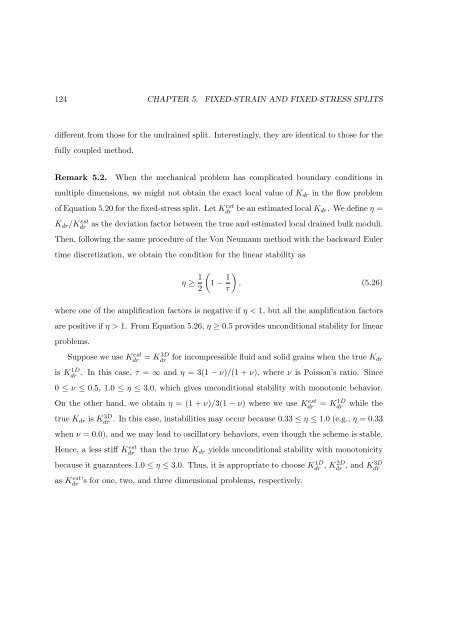Sequential Methods for Coupled Geomechanics and Multiphase Flow
Sequential Methods for Coupled Geomechanics and Multiphase Flow
Sequential Methods for Coupled Geomechanics and Multiphase Flow
You also want an ePaper? Increase the reach of your titles
YUMPU automatically turns print PDFs into web optimized ePapers that Google loves.
124 CHAPTER 5. FIXED-STRAIN AND FIXED-STRESS SPLITS<br />
different from those <strong>for</strong> the undrained split. Interestingly, they are identical to those <strong>for</strong> the<br />
fully coupled method.<br />
Remark 5.2. When the mechanical problem has complicated boundary conditions in<br />
multiple dimensions, we might not obtain the exact local value of Kdr in the flow problem<br />
of Equation 5.20 <strong>for</strong> the fixed-stress split. Let K est<br />
dr be an estimated local Kdr. We define η =<br />
Kdr/K est<br />
dr<br />
as the deviation factor between the true <strong>and</strong> estimated local drained bulk moduli.<br />
Then, following the same procedure of the Von Neumann method with the backward Euler<br />
time discretization, we obtain the condition <strong>for</strong> the linear stability as<br />
η ≥ 1<br />
<br />
1 −<br />
2<br />
1<br />
<br />
, (5.26)<br />
τ<br />
where one of the amplification factors is negative if η < 1, but all the amplification factors<br />
are positive if η > 1. From Equation 5.26, η ≥ 0.5 provides unconditional stability <strong>for</strong> linear<br />
problems.<br />
Suppose we use K est<br />
dr<br />
= K3D<br />
dr <strong>for</strong> incompressible fluid <strong>and</strong> solid grains when the true Kdr<br />
is K1D dr . In this case, τ = ∞ <strong>and</strong> η = 3(1 − ν)/(1 + ν), where ν is Poisson’s ratio. Since<br />
0 ≤ ν ≤ 0.5, 1.0 ≤ η ≤ 3.0, which gives unconditional stability with monotonic behavior.<br />
On the other h<strong>and</strong>, we obtain η = (1 + ν)/3(1 − ν) where we use K est<br />
dr<br />
= K1D<br />
dr<br />
while the<br />
true Kdr is K3D dr . In this case, instabilities may occur because 0.33 ≤ η ≤ 1.0 (e.g., η = 0.33<br />
when ν = 0.0), <strong>and</strong> we may lead to oscillatory behaviors, even though the scheme is stable.<br />
Hence, a less stiff K est<br />
dr than the true Kdr yields unconditional stability with monotonicity<br />
because it guarantees 1.0 ≤ η ≤ 3.0. Thus, it is appropriate to choose K 1D<br />
dr<br />
as Kest dr ’s <strong>for</strong> one, two, <strong>and</strong> three dimensional problems, respectively.<br />
, K2D<br />
dr , <strong>and</strong> K3D<br />
dr
















